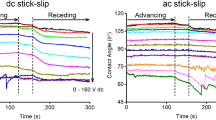Abstract
EWOD (electrowetting on dielectric) is a viable scheme to drive optofluidic devices that utilize the liquid interface as a refractive surface. Although AC (alternating current) voltage is often applied to an electrode in EWOD devices to improve electrical characteristics, it may cause oscillations of liquid interfaces which can be detrimental to the system’s performance as an optical device. Here we experimentally identify the origin of the interfacial oscillations of polymeric electrolyte solutions by observing the dynamic responses of contact lines as a function of the AC frequency. Penetration of small charged matters into the dielectric film of the opposite polarity is shown to induce the voltage relaxation that leads to deterioration of electrowetting performance. Measuring the relaxation time scale which is different for each polarity allows us to find the critical AC frequency that ensures stable interface control.
Similar content being viewed by others
References
A. W. Adamson and A. P. Gast, Physical Chemistry of Surfaces, Sixth Ed., Wiley, New York, USA (1997).
R. A. Hayes and B. J. Feenstra, Video-speed electronic paper based on electrowetting, Nature, 425 (2003) 383–385.
S. Yang, K. Zhou, E. Kreit and J. Heikenfeld, High reflectivity electrofluidic pixels with zero-power grayscale operation, Appl. Phys Lett, 97 (2010) 143501.
S. Kuiper and B. H. W. Hendriks, Variable-focus liquid lens for miniature cameras, Appl. Phys. Lett, 85 (2004) 1128–1130.
N. R. Smith, D. C. Abeysinghe, J. W. Haus and J. Heikenfeld, Agile wide-angle beam steering with electrowetting microprisms, Opt. Exp, 14 (2006) 6557–6563.
B. de Boer, F. Suijver, M. Megens, S. Deladi and S. Kuiper, Control of an electrowetting-based beam deflector, J. Appl. Phys, 107 (2010) 063101.
L. Hou, J. Zhang, N. Smith, J. Yang and J. Heikenfeld, A full description of a scalable microfabrication process for arrayed electrowetting microprisms, J. Micromech Microeng., 20 (2009) 015044.
D.-G. Lee, J. Park, J. Bae and H.-Y. Kim, Dynamics of a microliquid prism actuated by electrowetting, Lab Chip, 13 (2013) 274–279.
J. Cheng and C.-L. Chen, Adaptive beam tracking and steering via electrowetting-controlled liquid prism, Appl. Phys. Lett., 99 (2011) 191108.
M. Dhindsa, S. Kuiper and J. Heikenfeld, Reliable and lowvoltage electrowetting on thin parylene films, Thin Solid Films, 519 (2011) 3346–3351.
S. Berry, J. Kedzierski and B. Abedian, Low voltage electrowetting using thin fluoropolymer films, J. Colloid Interface Sci., 303 (2006) 517–524.
H. Moon, S. K. Cho, R. L. Garrell and C.-J. Kim, Low voltage electrowetting-on-dielectric, J. Appl. Phys., 92 (2002) 4080–4087.
M. K. Kilaru and J. Heikenfeld, Strong charge trapping and bistable electrowetting on nanocomposite fluoropolymer: BaTiO3 dielectrics, Appl. Phys. Lett., 90 (2007) 212906.
B. Raj, M. Dhindsa, N. R. Smith, R. Laughlin and J. Heikenfeld, Ion and liquid dependent dielectric failure in electrowetting systems, Langmuir, 25 (2009) 12387–12392.
S. Choi, Y. Kwon, Y.-S. Choi, E. S. Kim, J. Bae and J. Lee, Improvement in the breakdown properties of electrowetting using polyelectrolyte ionic solution, Langmuir, 29 (2012) 501–509.
S. Yang, K. Zhou, E. Kreit and J. Heikenfeld, High reflectivity electrofluidic pixels with zero-power grayscale operation, Appl. Phys. Lett., 97 (2010) 143501.
J. Zhang, D. van Meter, L. Hou, N. Smith, J. Yang, A. Stalcup, R. Laughlin and J. Heikenfeld, Preparation and analysis of 1-chloronaphthalene for highly refractive electrowetting optics, Langmuir, 25 (2009) 10413–10416.
Author information
Authors and Affiliations
Corresponding author
Additional information
Recommended by Associate Editor Jaewon Chung
Jaebum Park received his B.S. and M.S. degrees from Seoul National University all in mechanical engineering. He is currently a researcher of Institute of Advanced Machines and Design at Seoul National University. His research, interests include microfluid mechanics and multiphase flows.
Ho-Young Kim received his B.S. degree from Seoul National University and M.S. and Ph.D. degrees from MIT all in mechanical engineering. He is Professor of Mechanical Engineering at Seoul National University, and Fellow of American Physical Society. His research activities revolve around micro-fluid mechanics, biomimetics, and soft matter physics.
Rights and permissions
About this article
Cite this article
Park, J., Ha, J., Choi, K. et al. Critical AC frequency for stable operation of electrowetting-driven optofluidic devices with polymeric electrolyte solutions. J Mech Sci Technol 33, 1793–1797 (2019). https://doi.org/10.1007/s12206-019-0331-0
Received:
Revised:
Accepted:
Published:
Issue Date:
DOI: https://doi.org/10.1007/s12206-019-0331-0




